#so putting Adam's story parts into Mark's storyline would be. better than just repeating it twice.
Explore tagged Tumblr posts
Text
Figured i'd start actually. slowly reintroducing the new monster au turned oc project by first posting the new character names!
Mark -> Markus Adrianne Addams (Mark/Chris) Cesar -> Martin Garcia Sarah -> Amber Addams (Ace) Thatcher -> Jackson Hyde (Jack) Ruth -> Mabel Palmer Dave -> Barney Holmes Evelin -> Olivia Davis (Liv) Jonah -> Aaron Jones (AJ)
Another thing I wanted to introduce, this universe from now on will be referred to as Whispers of Willows!
#ramblings :)#Whispers of Willows#And uh. guess i'll. establish the character tags too. here we go#Shadow Mark#Mark Addams (WW)#(tagging both versions of his tag cause. yeag)#Martin Garcia (WW)#Amber Addams (WW)#Jackson Hyde (WW)#Mabel Palmer (WW)#Barney Holmes (WW)#Olivia Davis (WW)#Aaron Jones (WW)#Do i NEED to add the (WW) at the end of these tags? probably not but hey organization is neat#I dunno what to make the abbreviation considering. the options are taken. WOW means world of war craft and WW stands for wind waker so LIKE#but yeah. silly.#I already did like. a HUGE rehaul for the characters and storyline and honestly I think its an improvement.#I'll post the refs when i'm done with a good chunk of them!#also. in case you're wondering. we did lose someone.#Adam is NOT coming back in this. mainly due to 1. me wanting to make the adam stand ins for OTHER projects more unique#but also because. his storyline could be easily seen in MARKS storyline.#so putting Adam's story parts into Mark's storyline would be. better than just repeating it twice.#This effects Olivia's story of course but. i'll figure something out.#but yeah!! i'm happy with the progress made on this so far!!!!
37 notes
·
View notes
Photo
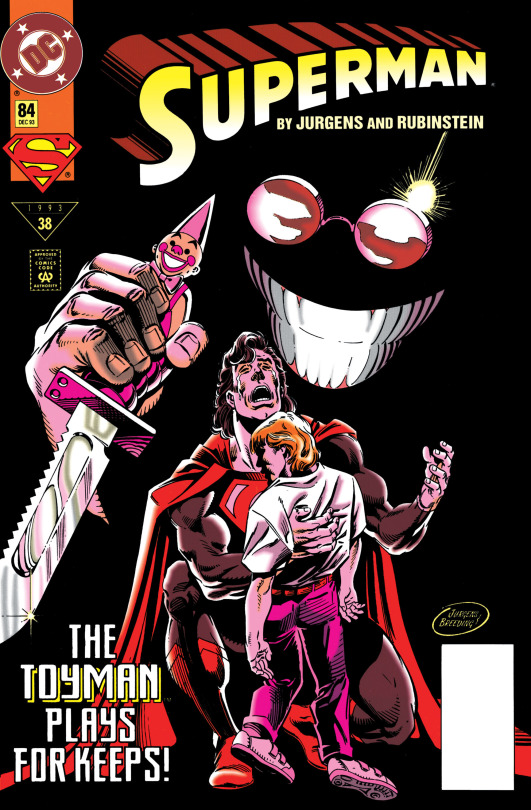
Superman #84 (December 1993)
Superman takes a short Paris vacation! Like, one day short. What's the worst that could happen?

Oh, man.
So, for the past few issues, we've been hearing about children being abducted in Metropolis. Now we see that they're being kept inside a giant toy house by some creepy bald man in Quasimodo clothes who seems to be obsessed with toys -- a "Man of Toys," if you will. Side note: no wonder the children haven't been found... all the articles about them are just gibberish! (See clip below.)
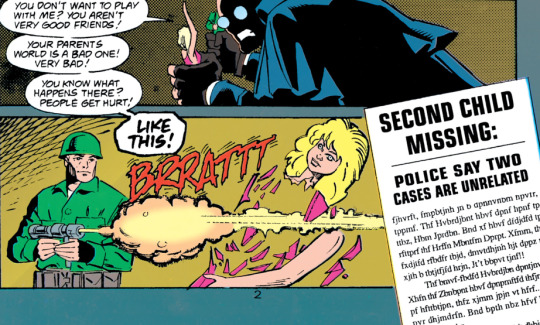
The kidnapper thinks that these kids' parents don't deserve them, and that they're much better off here, in an underground hideout with a man who threatens to starve them if they don't play with him. (And I do mean literally play, with action figures and stuff.) Meanwhile, as these children cry for help, Superman is having the time of his life. While helping move a stranded ship with some huge-ass chains, Superman spots a sunken galleon with a treasure chest inside and fantasizes about keeping the booty...

...before turning it over to the authorities anyway, the big boy scout. Then, he wakes up Lois at 6 AM and tells her they should go to Paris right now, which usually means your significant other is having a mental breakdown, but in this case they can actually do it. And so, after deciding that he deserves to use his powers for fun every once in a while, Superman and Lois drop everything and fly to France with super-speed for the rest of the day/issue.
Anyway: back to the child abduction! Cat Grant and her son Adam attend a Halloween party at Adam's school, but there's a disturbed weirdo in a hideous costume lurking among the crowd. Yes, I'm talking about Jimmy Olsen in his Turtle Boy suit.

Shortly after that, a guy in a dinosaur costume (see, all the creeps are dressed as reptiles) lures Adam out of the party with the promise of "superb video games." What child could resist that? Of course, that turns out to be the kidnapper and Adam ends up in his hideout along with the rest of the missing children and, worst of all, not a single "Lextendo" console.
The kidnapper gets angry at Adam when he refers to the toys at the hideout as "old-fashioned junk" (he was REALLY looking forward to those video games), and even angrier when Adam tries to free the other kids. Adam is brave and puts up a good fight, but...

And those were Adam Morgan's final words. "Uh-oh."
Next, we have a pretty harrowing scene of Detective Turpin letting Cat know Adam’s body was found, and Jimmy and Perry White taking her to the morgue to identify the body (most people probably wouldn't bring their former boss to something like that, but Perry sadly knows more than most about losing a kid). As for Lois and Clark, they were gone so long that the Daily Planet had time to print a headline about the murders. The issue ends when the lovebirds walk into the office smiling like two people who just spent the night fooling around in Paris... only to feel like jackasses when they find out what happened.
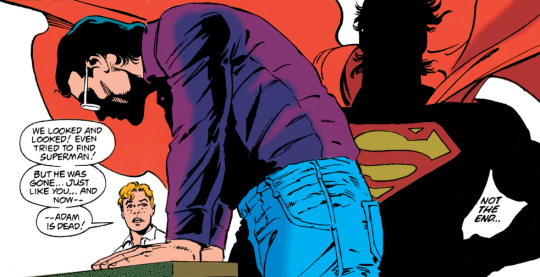
To be continued!
Character-Watch:
And that's it for little Adam Morgan who, unlike the also tragically diseased Jerry White, didn't even get any post-death appearances. Adam went from a little kid scared of Superman, to a huge brat, to a character who was approaching likeability as of last week. That's why I hate it when DC kills off young characters like Adam or Liam Harper: in long-form storytelling, children represent potential. Look at how much Wally West or Dick Grayson evolved over the years compared to their mentors! Sure, there's a huge probability that Adam would have ended up disappearing from comics for 25 years anyway, but who knows, maybe we'd now know him as Teen Gangbuster or something. GangbusTEEN.
This issue also represents a turning point for the kidnapper, who is never named or seen clearly in the story itself but I don't think I'm shocking anyone by spoiling the fact that he's Toyman (it's in the cover, for one thing). In his last two appearances before this storyline, Toyman helped Superman save some kids from Sleez and looked genuinely sad to learn about Superman's death, so this is a pretty dramatic change for the character. We'll find out why he went from big softy to child killer in Superman #85 (but don't get your hopes up).
Plotline-Watch:
The most disturbing part of the issue, all things considered, is still the part where Toyman climbs into a giant crib and hugs a huge stuffed bunny. Look at serial killer Tommy Pickles here:
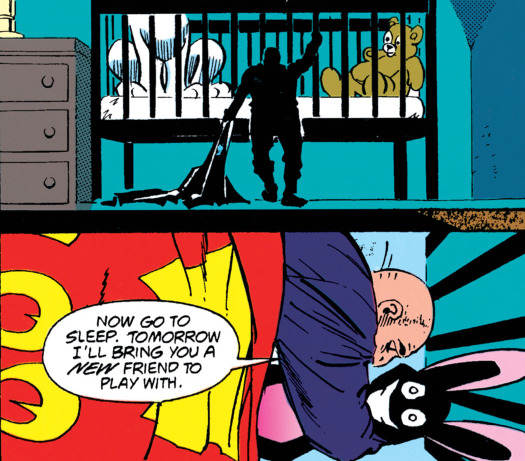
Don Sparrow says: “Even with the upgrade, Toyman is still just a man in a suit, a common complaint about Superman’s rogues gallery.” Funny you should say that, because I JUST shared an old Wizard interview in our Twitter in which Dan Jurgens talks about how Doomsday came out of his frustration with the fact that most Superman villains are dudes in suits (plus other interesting tidbits from the era, like how it was actually Roger Stern’s idea to bring back Hank Henshaw, so check out that link!).
Don again: “The entire Superman storyline of this issue feels like filler. Diving for buried treasure and soaring off to Paris -- it all feels like wasted time next to the Adam storyline.” I have a theory that the entire ship sequence is there as an excuse to put Superman in those big chains and make that Spawn joke (which I didn’t get until now, since I’ve always read this issue in Spanish).
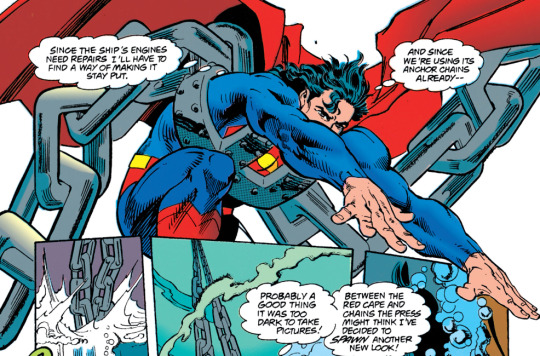
Superman says that pulling that big ship was "a little easier than expected" -- that's either another hint that there's something going on with Superman's powers since he came back, or a subtle dig at the state of American ship manufacturing.
Another adorable "window tap" scene for the books, and this is the sexiest one so far. Is it me or has Jurgens started copying more than just Teri Hatcher's hairdo from Lois & Clark? (For anyone who thinks Lois has gotten implants, I refer you to this clip.)

While in Paris, Lois asks Clark if he's ever wondered what would happen if his rocket had landed in other countries. Don: “Clark’s conversation with Lois sounds like a bunch of concepts for Elseworlds stories. We eventually would see a Russian Superman, and a British Superman, but not yet the French Superman. (Hire us, DC!)” Yep, got my French Superman pitch ready, Jim Lee. Or just let us do Russian Superman again, since Red Son wasn’t even the first time you published that idea.
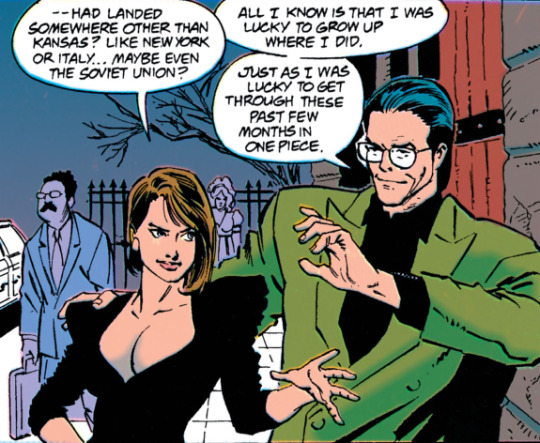
Don once more: “Another thing that makes no sense about the ‘new’ Toyman is his resentment of technological toys—when in previous appearances he himself had deadly high-tech toys to vex Superman over the years.” I especially resent his hatred of video game consoles. Incidentally, I wonder what types of games are available for Adam’s beloved Lextendo. Star Lex 64? Mega Man Lex? Sonic the Hedgehog 3 & Knuckles & Lex?
No one is more upset at Lois and Clark for going AWOL than Whit. NO ONE. He's so furious that his usually grey mustache turned black.

Patreon-Watch:
As always, shout out to our patrons, Aaron, Murray Qualie, Chris “Ace” Hendrix, britneyspearsatemyshorts, Patrick D. Ryall, Samuel Doran, Bheki Latha, Mark Syp, Ryan Bush and Raphael Fischer! Last month’s exclusive Patreon article was about the recently unearthed sequel to Superman 64 for the PlayStation, featuring Metallo, Parasite, and Lois looking even hotter than in this issue:
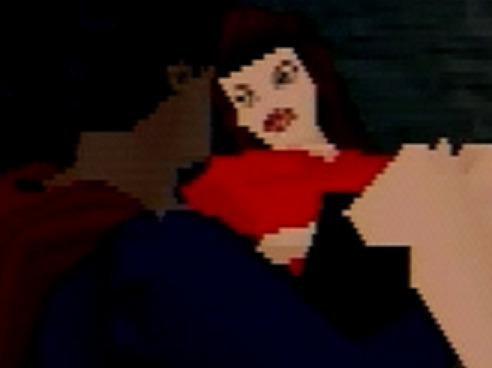
Hot damn. Find out more at https://www.patreon.com/superman86to99!
And believe it or not, Don Sparrow has even more to say about this issue. Read his section after the jump:
Art-Watch (by @donsparrow):
I should start off my section with a big caveat: I flat out hate this issue. There were several weird decisions made in the post-Death-and-Return era (most of them along the same lines of making the Superman titles more grim-and-gritty), and this story was one of the worst of them. My theory is that, despite the praise and record-breaking sales of the Death and Return storyline, the Superman creative team felt pressure to have more extreme storylines, perhaps in response to the wildly successful Image books coming out at the time. Between this story, and the upcoming “Spilled Blood” storyline, the Super books take a hard—but temporary--turn into more violent and upsetting storytelling—even though these stories are by the same writers as the previous few years. While death has always been a part of comics, and Superman comics was no exception, there is a jarring glibness and unfeeling toward the way violence is handled in these pages that is quite different from the stories that preceded it. It’s made all the more jarring by the fact that well-established personalities suddenly veer wildly out of character, Toyman chief among them.
We start with the cover, and while it is technically well-drawn (by the familiar team of Jurgens and Breeding) it’s also a very upsetting visual. I think they should have gone with the pieta type pose with Adam and Superman, OR the scary badass bowie-knife Toyman (who apparently has a Cheshire cat smile now) but not both. But the cover is a good hint at the tonal dissonance of the comic within.
We open with a splash of the now-extreme 90s looking Toyman, with his serial killer shaved head and spooky cloak, ignoring the pleas of hungry kids he has locked up in a tiny jail cell for days at a time (if that sentence doesn’t ring alarm bells for how wrong this is for a Superman story, I don’t know what will). For much of the issue Toyman’s eyes are obscured by glare on his lenses, further de-humanizing a character who was once one of Superman’s more empathetic bad guys.

We cut to Superman tugboating a huge tanker with giant chains and it’s a cool visual (one repeated in the Batman V Superman film). It feels especially out of place to focus on, given how upsetting this issue is otherwise, but throughout the whole comic, Lois is drawn smoking hot, especially on the two page spread on pages 9-10.

The scenes depicting the actual murder, while still wildly out of place in a Superman comic, are well done, and give a real sense of darkness and menace, which I suppose is the intent. Perhaps my least favourite visual is the Big Bird stuffie, silently bearing witness to what’s about to occur.

The edges of the panels on get more slashy and off-kilter (to me, looking very much like the layouts more typically seen in Image comics of the day) and I suppose I appreciate the restraint of how little Dan Jurgens shows of the death of a child, showing only a bloody slash on a black background. This is still a pretty baroque image for a Superman comic, but certainly less violent than it could be, given what is happening.
Cat Grant’s silent horror is well staged, and powerful in its way. Lastly, Clark Kent bending in sorrow and regret is a powerful image.

While this issue is handled marginally better, and more maturely than other comics on the shelf at this time, I still believe it is one of the biggest mistakes of the era. Giving a long-established character an unceremonious death for shock value is gross on its own, but making it a child definitely crosses a line for me. Making it worse is that, while the Toyman is a criminal and a killer, he has shown in past issues (a similar kidnapping storyline involving Sleez) that he genuinely cares for the well-being of children. So for a long-time reader, this also felt like a betrayal of a long-established, fully developed character. Adding to the ugliness of this is that Adam dies heroically, trying to free the children who have been caged, unfed, for days, but even in that regard, he fails. The headline at the end of the issue confirms all the children are dead. Adam’s death did not buy the other kids enough time to get away. It was all for nothing. Had Adam died, but the other children lived, maybe this issue wouldn’t leave quite as bad a taste. [Max: It’s weird because it’s all told in a way where it’s told in a way where it would make sense, narratively and within the story universe, that the other kids survived, but then it’s almost casually revealed that nope, they died too. A scene of one of the kids relaying Adam’s heroism to Cat in a future issue would have gone a long way.]
Superman doesn’t come off well in these pages, either. It’s honestly the type of story they should just stay away from, because the more you think about all the calamity that is going on around the clock, the less defensible the whole Clark Kent persona becomes. Superman carving out time to romance his fiancée directly led to the preventable deaths of innocent children—how do you come back from that?
STRAY OBSERVATIONS:
I’m always looking for hints that perhaps Jimmy or Perry know Superman’s secret identity deep down, and Jimmy’s anger at Lois and Clark on their return to the Daily Planet offices would seem to give that theory some credence, as he’s as angry at them as if he knew Clark really were Superman. Either that, or he’s ticked that it fell to him, and none of them to escort Cat into the morgue. [Max: Has this issue finally converted you to the “Jimmy is terrible” side now, Don?]
I don’t think I’m the only one who disliked the new Toyman—SPOILERS BE HERE: years later, in Action Comics #865, Geoff Johns retconned this whole story, reverting Schott into the criminal who over-relates to kids, rather than the child-killer of this story. Apparently the infantile Schott, who speaks to “Mother” a la Norman Bates, is a robot so lifelike it fools even Superman, and the “Mother” he’s constantly replying to was the real Winslow Schott trying to recall the malfunctioning robot. [Max: That’s one Geoff Johns retcon I really didn’t mind, even if it felt kind of derivative of his similar “all the Brainiacs are robots made by the real Brainiac” reveal.]
#superman#dan jurgens#josef rubinstein#toyman#cat grant#adam morgan#dan turpin#whit#gangbusteen#super luthor fighter ii turbo championship edition
33 notes
·
View notes
Text
Eurovision Song Contest: The Story of Fire Saga
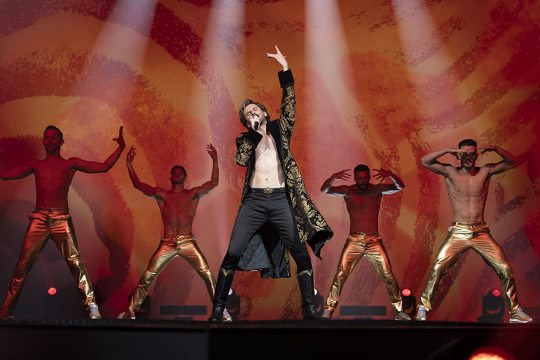
There’s bad, there’s good, and there’s Eurovision.
The European ‘Song’ Contest, to which this film for many will serve as introduction, neither sits at any apex of cultural achievement nor the ironic bulwarks of saccharine kitsch to which many entrants aspire. Rather, amidst its longevity and oddly unique role in cross-border co-operation, the competition, to which Australia is specially beholden, marks its own measures of success and brands of cultural height.
Tied not necessarily to any independent form, skill or recognisable ingenuity, appeal relies on brazenness, melding of styles and a nakedly single-minded, utterly shameless pursuit of shock-filled fun. To this end, it’s amazing Will Ferrell and Adam McKay haven’t mined these depths already.
Reportedly a huge fan of the show, Ferrell, committing as always, is regretfully on auto-pilot for whole lengths, drawing on the manner and storylines of his underrated Blades of Glory and early success Zoolander as regards the relationship between his Lars and the characters’ “extremely handsome father;” Pierce Brosnan having some fun with comedy for change.
The story is of the broadest if heart-warmingly familial strokes elevated by its novel focus on the tournament; anyone who’s seen more than one Ferrell comedy (Old School fans should recognise one of the gags) will be across these stylings; complete with a Blades-esque MacGuffin in the form of an unreachable note. We’re all familiar with the follow your dreams against all opposition arc and even if it can get tired it doesn’t get old.
With Ferrell persistently glaring at the camera ala his Mustafa and reminding everyone that he’s here to make them laugh, McAdams, unsurprisingly, is best in show. Her reactions to a pro forma troupe of yet unseen backup dancers invading her solo and her negotiations with a group of elves, yes elves; pure gold. Viewers seem to be constantly finding out that the severely underappreciated comic performer can put in turn after turn like this and unlike Ferrell nails the balance of earnestness, knowing self-seriousness and tactless flamboyance central to Eurovision’s greatest hits.
There’s a caveat that has to be given before anyone watches this movie and that is you are only going to enjoy this if you are moderately familiar with and endeared by Eurovision. The film does not serve as a primer for the uninitiated absent proper grounding in the dynamics of the competition and those unbeholden to its unique stylings will likely feel as unimpressed by Ferrell’s tonally similar antics.
For those most dedicated decades-long Eurovision fans who wake up at 5am every year to watch every Semi-Final live, this author among them, you will get many a high off of this and more so for our having sadly missed the contest in its traditional form this May past. To the filmmakers’ great credit, they picked Iceland as the focus and amidst many playful digs at the nation, the treatment of the Icelandic Government being a highlight, managed to nail the effective winners of this year’s non-tournament.
And it would not be a Eurovision movie without being (in respects) avowedly self-referential, with the film taking some time out of proceedings to address that this is in no small part a group of North Americans behind and in front of the camera. Taking the mickey via another appropriately parodic band of US tourists who have only just landed in town, it’s some of the tightest scripting therein as every line hits the mark. Itself landing on Netflix, Fire Saga is probably best served by a platform where the most well-attuned fans can discover this and return for repeat viewings at their leisure and as they might otherwise have tuned into the annual tradition.
The varied numbers (and song titles) which form the lead-up to and actual competition are successes not just for their catchiness and necessary originality but for effectively satirising one of the hardest things to mock and exaggerating that which barely bears exaggeration; generating in the process what would typically be Eurovision bangers in any given year. Graciously recognising that Belarus are invariably stand-outs, there’s a classy Lordi reference alongside years-old highlights and fair acknowledgement of the pivotal (if often biased) roles respective countries’ commentators play. The hark-backs to classic Eurovision numbers will have any fan beaming and the elapsing of the first Semi-Final, encompassing one of the great Eurovision props, is uproarious while speaking to the extremely sincere ethos of the entire escapade.
The blocking of the stage performances, akin to how the broadcasts are typically handled, are too coyly deferential and situate us amongst this extravagance better than a more highly stylised or numerous camera setup which would have likely faltered.
Stars of past, clearly having the time of their lives in this reunion, welcomely make appearances, among them Alexander Rybak (“trust us, bring a violin”), though the best and most welcome surprise comes from a winner of recent years lovingly reciting one of Eurovision’s very best numbers on Edinburgh’s streets.
On this, there are varyingly hilarious interpretations as to why the competition was set in Edinburgh. It could be acknowledging that the British are least likely to win this and if so even less likely to relegate the fanfare to Edinburgh, though with the Russian entrant (Downton Abbey’s Dan Stevens) explicitly lampooning the Isles’ standing in the tournament its more likely the filmmakers’ subtle advocacy of the longstanding hope that Scotland will one day get their own highly competitive place.
As to Stevens’ contender, it’s a well-known problem that many of the countries which participate have appalling records on human rights and LGBT welfare. Amidst a more dramatically sensitive reckoning with this matter, his performance, Stevens’ best to date, is outright hilarious as Lemtov lion-tames extremely scantily-clad men about the stage in typical Eurovision fashion.
Lovingly landing jabs on the annual extravaganza, infamous for its nondescript, heavily generic slogans, the tagline ‘Perfect Harmony’ for the in-film comp shows that we’re dealing with real fans here, as does moreover the exclamation, as to why there are no cars on the road, that everyone’s “at home, watching Eurovision.” The film too acknowledges the constant push for and joy when singers indeed sing in Indigenous languages or emphatically about wherever they’ve ventured from with several seemingly throwaway gags, including a great one centring on whales, happily coming full circle.
Absent the voting process, this is too a stickler for Eurovision lore and procedure; though Sweden did have seven performers on stage and should have been disqualified.
Finally, there’s an odd tone at the centre of this film which arrests it from the heights of greatness to which Eurovision otherwise transpires. Co-produced by Jon Ola Sand of the European Broadcasting Union who makes an appearance here and in every Eurovision, even if, and it would be fairly speculative and unusual if so, full creative and parodic freedom were permitted alongside the name’s licensing rights and co-operation, a parody, even a loving one, just isn’t the same when the subjects and stalwarts are so in on the joke and stand to so outwardly benefit.
Yes Eurovision relies to some extent on being self-referential ala ‘Love, Love, Peace, Peace’ but it was only one year among many where the hosts winkingly outshone competitors; the platform otherwise persisting on a lifeblood of entrants’ own (and self-professed devotees) earnest if outlandish skewering. Regular commentator Graham Norton’s true to life cameos are notably distinct and illustrative in this regard; his mawkish if impassioned demeanour emblematic of the tone pursued herein, just like a local townsman declaring “we know they’re awful, but they’re our awful!”
It’s why Trey Parker and Matt Stone refused celebrities the opportunity to voice their own marionettes in Team America, and why Zoolander 2 never worked when all the fashion icons wanted to show they could poke fun at themselves as well. Sure it meant a lot of the gags here might not have happened, but if they’d called it almost anything else the same niche audience would have lined up and there’s no way the winners past wouldn’t have joined the festivities for what turned out to be our collective annual dose of insanity.
‘Eurovision Song Contest: The Story of Fire Saga’ is now streaming on Netflix
#xl#reviews#netflix#eurovision#eurovision song contest: the story of fire saga#will ferrell#rachel mcadams#graham norton#pierce brosnan
3 notes
·
View notes
Text
A Mid-Volume RevieWBY
Let’s be honest. Most of us were holding our breath for the entire hiatus: we’ve been burned before by this show.
RWBY has always been a show with potential, but has been unable to get as big as it wants to be just due to the nature of how it’s made. Rooster Teeth is still an independent production studio, they can only put out so many episodes a year, and for the past two volumes it was just two guys writing basically everything.
It’s also worth pointing out that RWBY wasn’t originally a masterpiece on its own. What made it stand out was a) the fact that the mostly comedy-driven Rooster Teeth was making an original IP and b) the fights. People jumped onto this show because even if the animation quality was subpar, the vocal performances were all over the place, and the writing was slow as hell, there was charm to it, and part of that charm was watching the show gradually improve.
Which is why everything started to feel stagnant when the show stopped improving. Sure, they upgraded to a more professional-looking animation engine, they started hiring more professional voice actors and the original cast’s performances improved with experience, but with the loss of the series’ creator, visionary, and key animator, the ability to have epic fights was lost, as was a major guiding force for where the show could go. Couple that with key missteps in major storytelling in Volume 4 and 5 (including storylines that were just completely dropped or failed to receive any focus) and wildly inconsistent fight quality from chapter to chapter, the show was getting so many things wrong. Yeah, some of the criticism was just unnecessarily toxic, and I recognize the CRWBY’s discomfort at the level of hate they were getting (no one’s forcing you to watch the show, people), but seriously, it got to the point that even some of the show’s more positive fans were calling RWBY out for its problems. These issues were finally acknowledged by the team in a Reddit AMA following the Volume 5 finale, and they promised they would try to fix them. Miles himself posted this:

A couple of us went into this Volume with cautious optimism. While Volume 5 had been a disappointment, some of the new guiding philosophies they were claiming to use to fix RWBY for the next Volume had been used surprisingly successfully for Nomad of Nowhere. Everyone thought that show was going to be another cancelled-after-one-season failure for RT Animations, but surprisingly it turned out to be one of their best shows. If they could create another entirely new world and actually do some really good storytelling, maybe there was hope for RWBY.
If you saw the Volume 6 premiere in theaters like me, you may have watched with baited breath. They felt the need to screen the last hour of Volume 5 first, which just served as a reminder of how disappointing the overall product had been. Then they showed a behind the scenes video where the CRWBY discussed changes to the pipeline: a new co-director for the series, an actual writing team to assist Miles and Kerry, the animators being given more control on certain scenes, etc. etc. Overall, suggesting “We heard you and we’re going to try to improve.”
And then the first episode was shown. And honestly? It was pretty good. Good balance of humor and action while starting up some of the major storylines of the season. The fight scenes were well-choreographed, they’d clearly spent a lot of time working on the episode, they even had time to add little details and quirks to the character. It’s probably one of the best premieres of the entire show: it felt like it was doing a better job of marking a new era for the show than the Volume 4 premiere had been trying to do.
So, let’s assess how things have gone, at least so far.
Focus
This has been the biggest improvement for the show. The big problem in Volume 4 and 5 was having the team split up and attempting to give each their individual focus, while also giving secondary characters basically the same amount of focus, which was waaaay beyond what this kind of show could do. There were simply too many story threads and events going on that made following the show fun to watch––whole storylines would be dropped for several episodes at a time. I mean, the whole reason the Apathy didn’t appear in Volume 4 despite what they’d planned was because there just wasn’t any time to include them. As of now, there are only two major story threads we’ve been concerned with: Team QRWBYOM and Team Melted Ice Cream. A third could be Salem’s faction, but they’ve only had one scene so far: I suspect they’re going to play a more major role in the second half of this volume, though, considering they were waiting for the heroes to reach Argus. A fourth is Adam, but he also has only had one actual scene so far, I wouldn’t be surprised if they pushed him aside for the first half so they could focus on the main characters and he’ll have a bigger role later on.
This renewed focus has allowed us to finally get some proper interaction within the main team, plus actual character development. So, good on that.
Pacing
So much better. Volumes 4 and 5 relied way too much on cliffhangers to get people to come back each episode, instead of relying on a story playing out in single chapters. When I say cliffhangers, I mean cutting off a key story moment in the name of shock or not allowing the episodes to stand on their own. We’ve gotten a lot of episodes with an individual focus where they could potentially stand as an independent episode of the show, even the more arc-like episodes like what happened with Brunswick Farms: "The Coming Storm,” the second episode of that arc, had the Cinder vs. Neo fight that everyone adored and some amazing interactions with Blake and Yang and Weiss and Ruby.
I had a concern that having major revelations/moments in only the first few chapters was going to kill the pacing for the entire volume, and I still kind of have that concern. That said, I am surprised that they’ve kept up the momentum this far into the volume, so I’m cautiously optimistic. With maybe the exception of Chapter 4, each episode had a major story beat that packed a punch the volume needed to keep going.
Tone
This has been another problem for the past two volumes: the show kind of established itself with the anime vibe of visual comedy mixed with legitimate drama, but hasn’t really kept up that momentum volume-to-volume. In the cases of Volumes 4 and 5, they both began with some anime-like humor but failed to use it consistently. These seven chapters, meanwhile, have been pretty consistent in delivering those humorous moments: even Brunswick Farms, the most horror-based arc in the series thus far, has some laugh out loud scenes.
And on that note: the horror elements of the Brunswick Farm arc were really well done. Sure, there was no way anyone was going to die, but that doesn’t really matter (repeat: THAT DOES NOT MATTER, CERTAIN PEOPLE) because a combination of writing, animation, and even sound design made for a couple of episodes that were legitimately terrifying.
Animation
I don’t want to make too many calls on this because I’m not that great at assessing this kind of thing (writing’s more my forte), and @hypeathon writes some really great analyses on the topic, much better than I ever could. But overall I think it’s safe to say the animation quality has really improved. You can really tell with certain episodes that more time was spent to make them look their best, especially Chapter 1, which had these little touches that I wouldn’t have expected at all from the show five years ago. Minus a couple of animation errors here and there, things are looking good. No random teleportation, all the fight scenes we’ve gotten have been sufficiently epic, they’ve been placed at points in the show that satisfy our epic fight cravings, overall, good work. Kind of the payoff to the mention from the premiere documentary that they’re leaving a lot of creative decisions in the hands of the animators, which has overall made a much prettier-looking show.
Character Development
One of the problems of juggling multiple storylines in Volumes 4 and 5 was that we weren’t given a whole lot to work with in terms of character development: a lot of it seemed to just happen offscreen, we weren’t really shown what changed a character from the start of a volume to the end of one. The biggest victims of this problem were the core four, who were often pushed aside in favor of development for side characters. Ruby has been the biggest victim of this problem, with a planned arc about her survivor’s guilt in Volume 4 getting pushed aside to focus on Ren’s story, and only really getting one legit moment of development in Volume 5 in her brief talk with Oscar. Yang’s arc about recovering from the Battle of Beacon was almost non-existent in Volume 4, with only a few drops of it popping up at moments in Volume 5 that didn’t form a cohesive development arc. Blake and Weiss actually had a decent arc, but Weiss wasn’t given a whole lot to do in Volume 5 and then kinda sorta got fridged for an episode or two.
With the characters reunited and a renewed focus on the core team, we’re finally seeing some actual on-screen development. Chapter 5 “The Coming Storm” is the clearest example of that, with the team dealing with the fallout from Jinn’s story in (what appeared to be) a lower-stakes setting. Key moments included Blake and Yang’s interaction, which brought the much-desired angst everyone was waiting for, knowing how betrayed Yang felt when Blake abandoned her at the end of Volume 3. Ruby and Weiss, who were set up from the beginning of the whole show as partners, weren’t really interacting a lot, even when they reunited midway through Volume 5. We get a nice moment of their dynamic while they’re looking for food.
Jaune
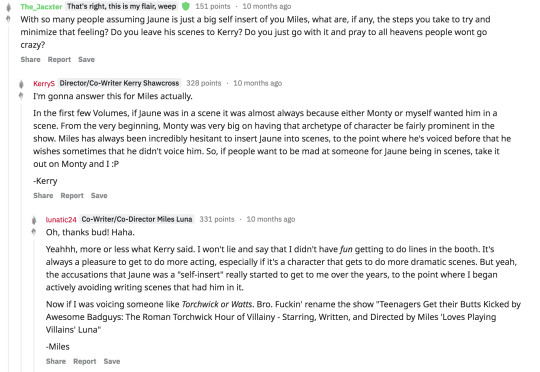
Well. That might explain why he’s gone for most of the first half.
(listen rwde, they’re never gonna get rid of him completely. He’s an established character, they can only push him aside for most of the volume, stop chasing your tail and get over it already. If they abruptly killed him I’m sure you’d be celebrating but all of us would be thinking “What...what purpose does that serve to the overall plot?”)
Storytelling
This is probably the best Volume in terms of storytelling. After years of World of Remnants and exposition dumps delivered by characters standing around talking, the philosophy of “Show, don’t tell” finally actually happened on this show. Flashbacks, which didn’t happen much (if at all) before, were finally used, and we ended up with some great material: again, the Grimm Reaper flashback in Chapter 7 continues the volume riding high on good quality fight animation, but also gives us a sense of the world the characters inhabit. More than before, a lot of minor things in this world are implied rather than fed to us, like the danger Silver-Eyed Warriors have to live with, the efforts people will go to to live out normal lives in Grimm-infested territory, etc.
I brought this up earlier, but Chapter 3 “The Lost Fable” was basically to RWBY what “El Rey” was to Nomad of Nowhere: a massive lore-dump that provided some much-needed context to what the heroes were doing, completely changing the stakes of the show up to that point and potentially changing the course of everything for the rest of the season. And we desperately needed that kind of episode, where we were shown instead of told the background of Ozpin and Salem, instead of just blindly thinking “Here’s the good guy and here’s the bad guy.”
And yet if I’m being honest, I can’t say I really liked it. I’m not sure why, maybe I’ve gotten cynical like the rest of the angry commenters on YouTube, it feels a bit like this is happening way too late, like it should not have taken this many years for something like this to be revealed, or there should have been a much better buildup to that reveal. At the same time, I understand that some major events in RWBY’s production (the least of which was the way too large scope of Volume 4 and the biggest of which was the shocking loss of its creator right when the show was about to enter a shift in tone) meant any proper buildup had to be killed in favor of telling cohesive stories volume-to-volume. So yeah, I can’t say I liked that episode individually, but I know the greater purpose it serves to the show so it doesn’t really bother me that much.
Conclusions
I try to be positive with my reviews of RWBY, especially considering how vitriolic reviews of this show can get. That said, this volume’s not perfect. The big criticism I have right now is that this is a show that wants to tell an epic story on a grand scale but can only tell it in fourteen 10-20 minute episodes per season. It doesn’t help that the last two volumes were the attempted execution of that plan, while this one seems to be scaling that back so the show doesn’t lose focus. But that’s just my issue with how the show has tried to established itself in the post-V3 era and how we’re no longer getting that. I think the biggest improvement this show could have would be longer episodes, and I could sacrifice having a volume per year if it meant they could spend more time on the episodes and tell the big story they want to tell. But I know Rooster Teeth can’t function as a production studio while only putting out one volume of RWBY, its flagship show (sorry RvB), every few years. Actually, I suspect that might be the model gen:LOCK is gonna follow, considering the first season alone has taken a year and a half to produce.
At the conclusion of Volume 5 I remarked that even though it was a disappointment, it was an obvious step in the creative direction the show needed to go in. Even if the fight animation was very often subpar and it felt like they were trying to clean things up after Volume 4 got too big to handle, there was a better blend of storytelling and action.
This volume so far has been the payoff. I haven’t felt the urge to seethe through my teeth with disappointment after a single episode this volume: each one was satisfying in its own way, I no longer feel like I have to keep track of 200 different characters and what they’re up to, and I walk away from the fight scenes feeling like something epic actually occurred rather than “Okay, so they punched things defied gravity and that somehow defeated their enemies.”
Yes, there are problems, but the show is showing clear signs of improvement. I think it’s safe to say after seven fairly good episodes that Volume 6 could very well become the best volume of RWBY. Any clear issues with the story and scope for this volume should’ve come up by now, and nothing really comes to mind. As far as I’m concerned, as a serialized TV show RWBY is succeeding. Whether that will all payoff for the final overall volume? Well, we’ll have to wait til the finale airs in February.
11 notes
·
View notes